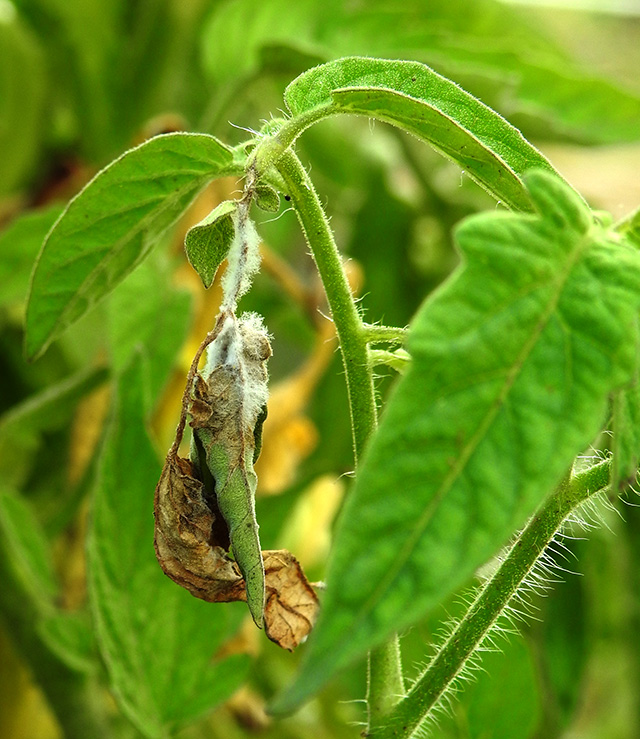White mold (aka timber rot) has been observed occasionally on Long Island in tomatoes growing in the field and in high tunnels. This disease has also been seen affecting tomato transplants in a greenhouse. Other crops observed affected in the area include beans, cabbage, lettuce, pepper, and winter squash.
Diagnostic feature for white mold is the black, hard structures resembling rat droppings the pathogen forms on or in diseased tissue (sclerotia). These are inside tomato stems that are white and dry because of the disease. Sclerotia are how the pathogen survives for many years. It is worthwhile, especially in high tunnels, to remove affected plant tissue and thus the pathogen’s survival structures.
Important facts to know about this disease pertinent for management include:
- The pathogen is monocyclic and thus does not spread from an infection site during a season.
- The pathogen can survive for years in soil.
- Many plants are susceptible.
Most fungal pathogens infecting foliar plant tissue produce spores that are dispersed (typically by wind or splashing water) to healthy plant tissue where they germinate, infect, and initiate a new infection cycle. This cycle is repeated several times within a cropping period (polycyclic). The white mold pathogen (Sclerotinia sclerotiorum) does not produce spores like this on diseased plant tissue. Therefore fungicides are only recommended before, not after, symptoms develop. The spores (ascospores) responsible for starting the single infection cycle are produced by the pathogen from small mushroom-like structures (apothecia) developing from sclerotia near the soil surface when soil is cool (50 – 68 F) and wet (near saturation). Ascospore germination and infection occurs during long periods (16 – 48 hours) that foliar tissue is wet. Often dying or dead tissue, such as senescing flowers and leaves, are infected first.
Where white mold is confirmed to have occurred in the past, consider applying Contans to soil before planting. It is a biological fungicide that acts on sclerotia. Other fungicides for foliar application need to be applied before infection. Endura is a conventional fungicide that can be applied to foliage. Double Nickel is an organic fungicide that exhibited good efficacy for white mold in snap beans through research conducted upstate.
Also use cultural management practices that minimize wetness periods, such as wide row spacing, trellising, drip irrigation, and orienting rows parallel to the main wind direction. Manage weeds. Till deeply to bury sclerotia where removing affected plant tissue is not feasible. Effective rotation is challenging due to the pathogen’s wide host range and ability to survive in soil as sclerotia for at least 5 years.
More information:
- White mold and its management in cabbage, beans, and other vegetables
- White Mold in The Plant Health Instructor.
Please Note: Fungicides mentioned are for use in commercial production, not gardens. The specific directions on pesticide labels must be adhered to — they supersede these recommendations if there is a conflict. Any reference to commercial products, trade or brand names, is for information only; no endorsement is intended. For up-to-date information on labeled conventional fungicides see Cornell Integrated Crop and Pest Management Guidelines for Commercial Vegetable Production and biopesticides see the Biopesticides website.
Following two images are of white mold which has killed a tomato plant growing in a high tunnel.

Following two images are white mold affecting tomato seedlings in a greenhouse. Sclerotia (black structure indicated by arrow in second image) formed on affected seedlings kept in a sealed plastic bag within 5 days, which confirmed it is white mold. How quickly the pathogen produced its survival structure documents that it is important to promptly remove affected plants. Additionally, the pathogen can spread to adjacent healthy plants in contact. First image taken by grower; second by Margery Daughtrey.













